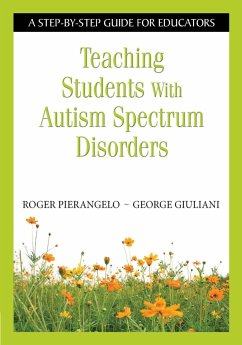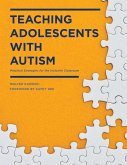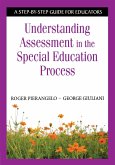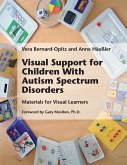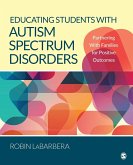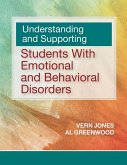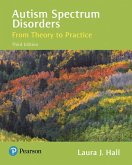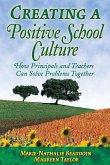Roger Pierangelo, George Giuliani
Teaching Students With Autism Spectrum Disorders
A Step-by-Step Guide for Educators
Roger Pierangelo, George Giuliani
Teaching Students With Autism Spectrum Disorders
A Step-by-Step Guide for Educators
- Broschiertes Buch
- Merkliste
- Auf die Merkliste
- Bewerten Bewerten
- Teilen
- Produkt teilen
- Produkterinnerung
- Produkterinnerung
Create an appropriate learning environment to help children with ASD develop lifelong independence! This user-friendly resource summarizes current research and presents a comprehensive overview of how to teach students with autism spectrum disorders (ASD). In a step-by-step format, the book covers intervention strategies for implementing effective programs that give youngsters with ASD the opportunity to learn and interact with their peers. The authors cover specific disorders and discuss: Specific instructional approaches Behavioral, skill-based, and physiologically-based intervention models…mehr
Andere Kunden interessierten sich auch für
![Teaching Adolescents with Autism Teaching Adolescents with Autism]() Walter KaweskiTeaching Adolescents with Autism13,99 €
Walter KaweskiTeaching Adolescents with Autism13,99 €![Understanding Assessment in the Special Education Process Understanding Assessment in the Special Education Process]() Roger PierangeloUnderstanding Assessment in the Special Education Process32,99 €
Roger PierangeloUnderstanding Assessment in the Special Education Process32,99 €![Visual Support for Children With Autism Spectrum Disorders Visual Support for Children With Autism Spectrum Disorders]() Vera Bernard-OpitzVisual Support for Children With Autism Spectrum Disorders30,99 €
Vera Bernard-OpitzVisual Support for Children With Autism Spectrum Disorders30,99 €![Educating Students with Autism Spectrum Disorders Educating Students with Autism Spectrum Disorders]() Robin LabarberaEducating Students with Autism Spectrum Disorders92,99 €
Robin LabarberaEducating Students with Autism Spectrum Disorders92,99 €![Understanding and Supporting Students with Emotional and Behavioral Disorders Understanding and Supporting Students with Emotional and Behavioral Disorders]() Vern JonesUnderstanding and Supporting Students with Emotional and Behavioral Disorders79,99 €
Vern JonesUnderstanding and Supporting Students with Emotional and Behavioral Disorders79,99 €![Autism Spectrum Disorders Autism Spectrum Disorders]() Laura HallAutism Spectrum Disorders92,99 €
Laura HallAutism Spectrum Disorders92,99 €![Creating a Positive School Culture Creating a Positive School Culture]() Marie-Nathalie BeaudoinCreating a Positive School Culture41,99 €
Marie-Nathalie BeaudoinCreating a Positive School Culture41,99 €-
-
-
Create an appropriate learning environment to help children with ASD develop lifelong independence! This user-friendly resource summarizes current research and presents a comprehensive overview of how to teach students with autism spectrum disorders (ASD). In a step-by-step format, the book covers intervention strategies for implementing effective programs that give youngsters with ASD the opportunity to learn and interact with their peers. The authors cover specific disorders and discuss: Specific instructional approaches Behavioral, skill-based, and physiologically-based intervention models A comprehensive team approach that includes parents Assistive technology options Support services for transition to adult life
Hinweis: Dieser Artikel kann nur an eine deutsche Lieferadresse ausgeliefert werden.
Hinweis: Dieser Artikel kann nur an eine deutsche Lieferadresse ausgeliefert werden.
Produktdetails
- Produktdetails
- Verlag: Corwin
- Seitenzahl: 226
- Erscheinungstermin: 4. April 2008
- Englisch
- Abmessung: 254mm x 178mm x 13mm
- Gewicht: 434g
- ISBN-13: 9781412917087
- ISBN-10: 1412917085
- Artikelnr.: 23242681
- Herstellerkennzeichnung
- Libri GmbH
- Europaallee 1
- 36244 Bad Hersfeld
- gpsr@libri.de
- Verlag: Corwin
- Seitenzahl: 226
- Erscheinungstermin: 4. April 2008
- Englisch
- Abmessung: 254mm x 178mm x 13mm
- Gewicht: 434g
- ISBN-13: 9781412917087
- ISBN-10: 1412917085
- Artikelnr.: 23242681
- Herstellerkennzeichnung
- Libri GmbH
- Europaallee 1
- 36244 Bad Hersfeld
- gpsr@libri.de
Roger Pierangelo is an associate professor in the Department of Special Education and Literacy at Long Island University. He has been an administrator of special education programs and served for eighteen years as a permanent member of Committees on Special Education. He has over thirty years of experience in the public school system as a general education classroom teacher and school psychologist, and is a consultant to numerous private and public schools, PTAs, and SEPTA groups. Pierangelo has also been an evaluator for the New York State Office of Vocational and Rehabilitative Services and a director of a private clinic. He is a New York State licensed clinical psychologist, certified school psychologist, and a Board Certified Diplomate Fellow in Child and Adolescent Psychology and Forensic Psychology. Pierangelo is currently president of The National Association of Special Education Teachers, executive director of The American Academy of Special Education Professionals, and vice-president of The National Association of Parents with Children in Special Education. Pierangelo earned his BS degree from St. John¿s University, his MS from Queens College, Professional Diploma from Queens College, PhD from Yeshiva University, and Diplomate Fellow in Child and Adolescent Psychology and Forensic Psychology from the International College of Professional Psychology. He is a member of the American Psychological Association, New York State Psychological Association, Nassau County Psychological Association, New York State Union of Teachers, and Phi Delta Kappa. Pierangelo is the coauthor of numerous books, including The Big Book of Special Education Resources and The Step-by-Step Book Series for Special Educators.
Preface
Acknowledgments
About the Authors
1. Introduction to ASD
IDEA Definition of ASD
Overview of ASD
Causes of ASD
Prevalence and Incidence of ASD
Age of Onset of ASD
Gender Features of ASD
Cultural Features of ASD
Familial Pattern of ASD
Educational Implications of Students With ASD
Evidence-Based Practice in Working With Children With ASD and Their
Families
Research Basis for Services to Children With ASD in the Home, School, and
Community
2. Characteristics of Children With ASD
Possible Early Indicators of ASD
Patterns of Development
Impairments in Social Skills
Impairments in Communication Skills
Unusual and Repeated Behaviors and Routines
Additional Disabilities and Co-Morbid Conditions
Associated Features
3. Types of ASD
Autistic Disorder (Classic ASD)
Childhood Disintegrative Disorder
Rett Syndrome
Pervasive Developmental Disorder, Not Otherwise Specified (PDD-NOS)
Asperger Syndrome
4. Eligibility Criteria for Children With ASD
Review of the Characteristics of Children With ASD
Determination of the Procedures and Assessment Measures to Be Used
Determination of Eligibility for a Diagnosis of ASD
5. Overview of Effective Interventions
Behavioral Approaches
Relationship-Based Models
Skills-Based Interventions
Structured Teaching
Physiologically-Based Interventions
6. Creating Quality Educational Programs for Children With ASD
Family Involvement
Comprehensive Assessment of Skills and Deficits
Plan Development/Clearly Defined Goals and Objectives
Effective Teaching Strategies
Assessment of the Intervention
Structuring the Environment
Applying Functional Behavior Assessment to Problem Behavior
Transition
Opportunities With Peers
Comprehensive Team Approach
7. Collaborating With Parents
Obtaining a Diagnosis
Adjusting to the Diagnosis
Developmental Stages and Family Stresses
Creating a Collaborative Home-School Partnership
Building an Informed Partnership
Establishing a Team Approach
Planning for Communication
Facilitating Collaborative Relationships
When Collaboration Becomes Difficult
8. Effective Programming for Young Children With ASD: Ages 3-5
Curriculum Content
Highly Supportive Teaching Environments
Need for Predictability and Routine
Functional Approach to Challenging Behaviors
Transition Planning From Early Childhood Program to Elementary School
Family Involvement
9. Teaching Students With ASD: Instructional Approaches
Visual Approaches
Providing Precise, Positive Praise While the Student Is Learning
Using Meaningful Reinforcements
Planning Tasks at an Appropriate Level of Difficulty
Using Age-Appropriate Materials
Providing Opportunities for Choice
Breaking Down Oral Instructions Into Small Steps
Paying Attention to Processing and Pacing Issues
Using Concrete Examples and Hands-on Activities
Using Task Analysis
Using Discrete Trial Methods
Introducing Unfamiliar Tasks in a Familiar Environment When Possible
Organizing Teaching Materials and Situation to Highlight What Is Important
Encouraging Independent Effort and Incorporate Proactive Measures to Reduce
the Likelihood of Becoming Dependent on Prompts
Directing and Broadenening Fixations Into Useful Activities
Knowing the Individual and Maintaining a List of Strengths and Interests
Developing Talent and Interest Areas
10. Teaching Students With ASD: Strategies for Classroom Management
Providing a Structured, Predictable Classroom Environment
Providing a Customized Visual Daily Schedule
Noting Aspects of the Tasks and Activities That Create Frustration
Providing Relaxation Opportunities and Areas
Providing Opportunities for Meaningful Contact With Peers Who Have
Appropriate Social Behavior
Planning for Transitions and Preparing the Student for Change
11. Teaching Students With ASD: Strategies for Communication Development
Learning to Listen
Developing Oral Language Comprehension
Developing Oral Language Expression
Developing Conversation Skills
Echolalia
Using Alternative or Augmentative Communication Systems
12. Teaching Students With ASD: Strategies for Social Skills
Using Social Stories
Teaching Key Social Rules
Using Cognitive Picture Rehearsal
Using Peer Support
Using Social Skills Training Groups
Integrating Play Groups
Teaching Self-Monitoring/Managing Skills
Supporting the Development of Friendships
13. Teaching Students With Asperger Syndrome
Training
Characteristics and Learning Styles
Social Relation Difficulties
Social Communication Difficulties
Language Comprehension/Auditory Processing Difficulties
Sensory Processing Difficulties
Difficulty Representing Language Internally
Insistence on Sameness
Poor Concentration/Distractibility
Emotional Vulnerability
Restricted/Perseverative Range of Interest
Theory of Mind Deficit--Difficulty Taking the Perspective of Others
14. Assistive Technology for Children With ASD
What Is Assistive Technology?
Visual Representation Systems
Low-Tech Strategies
Mid-Tech Strategies
High-Tech Strategies
15. Behavior and Discipline Issues for Students With ASD
Developing Appropriate Behaviors for Students With ASD
Behavior Plan Key Idea: Use a PROACTIVE Approach
What to Do When a Student With ASD Engages in Inappropriate Behavior
Specific Behaviors of Concern
Other Possible Reasons for Problem Behaviors
16. Facilitating Inclusion
Teacher Preparation
Preparing Students With ASD
Promoting Understanding
Adapting Instruction
Adapting Equipment
Adapting the Physical Environment
Adapting Evaluation Methods
Adapting Assignments
Adapting Input Methods
Adapting Output Methods
Modifying Content and Difficulty Levels
Promoting Organization
One-to-One Instruction
Promoting Positive Peer Interactions
17. Transition Planning for Students With ASD
Strategies to Help With Transitions Between Activities and Settings
Transitions Between Grade Levels
Transitions Between Schools
Transition from High School to Adult Life
References
Index
Acknowledgments
About the Authors
1. Introduction to ASD
IDEA Definition of ASD
Overview of ASD
Causes of ASD
Prevalence and Incidence of ASD
Age of Onset of ASD
Gender Features of ASD
Cultural Features of ASD
Familial Pattern of ASD
Educational Implications of Students With ASD
Evidence-Based Practice in Working With Children With ASD and Their
Families
Research Basis for Services to Children With ASD in the Home, School, and
Community
2. Characteristics of Children With ASD
Possible Early Indicators of ASD
Patterns of Development
Impairments in Social Skills
Impairments in Communication Skills
Unusual and Repeated Behaviors and Routines
Additional Disabilities and Co-Morbid Conditions
Associated Features
3. Types of ASD
Autistic Disorder (Classic ASD)
Childhood Disintegrative Disorder
Rett Syndrome
Pervasive Developmental Disorder, Not Otherwise Specified (PDD-NOS)
Asperger Syndrome
4. Eligibility Criteria for Children With ASD
Review of the Characteristics of Children With ASD
Determination of the Procedures and Assessment Measures to Be Used
Determination of Eligibility for a Diagnosis of ASD
5. Overview of Effective Interventions
Behavioral Approaches
Relationship-Based Models
Skills-Based Interventions
Structured Teaching
Physiologically-Based Interventions
6. Creating Quality Educational Programs for Children With ASD
Family Involvement
Comprehensive Assessment of Skills and Deficits
Plan Development/Clearly Defined Goals and Objectives
Effective Teaching Strategies
Assessment of the Intervention
Structuring the Environment
Applying Functional Behavior Assessment to Problem Behavior
Transition
Opportunities With Peers
Comprehensive Team Approach
7. Collaborating With Parents
Obtaining a Diagnosis
Adjusting to the Diagnosis
Developmental Stages and Family Stresses
Creating a Collaborative Home-School Partnership
Building an Informed Partnership
Establishing a Team Approach
Planning for Communication
Facilitating Collaborative Relationships
When Collaboration Becomes Difficult
8. Effective Programming for Young Children With ASD: Ages 3-5
Curriculum Content
Highly Supportive Teaching Environments
Need for Predictability and Routine
Functional Approach to Challenging Behaviors
Transition Planning From Early Childhood Program to Elementary School
Family Involvement
9. Teaching Students With ASD: Instructional Approaches
Visual Approaches
Providing Precise, Positive Praise While the Student Is Learning
Using Meaningful Reinforcements
Planning Tasks at an Appropriate Level of Difficulty
Using Age-Appropriate Materials
Providing Opportunities for Choice
Breaking Down Oral Instructions Into Small Steps
Paying Attention to Processing and Pacing Issues
Using Concrete Examples and Hands-on Activities
Using Task Analysis
Using Discrete Trial Methods
Introducing Unfamiliar Tasks in a Familiar Environment When Possible
Organizing Teaching Materials and Situation to Highlight What Is Important
Encouraging Independent Effort and Incorporate Proactive Measures to Reduce
the Likelihood of Becoming Dependent on Prompts
Directing and Broadenening Fixations Into Useful Activities
Knowing the Individual and Maintaining a List of Strengths and Interests
Developing Talent and Interest Areas
10. Teaching Students With ASD: Strategies for Classroom Management
Providing a Structured, Predictable Classroom Environment
Providing a Customized Visual Daily Schedule
Noting Aspects of the Tasks and Activities That Create Frustration
Providing Relaxation Opportunities and Areas
Providing Opportunities for Meaningful Contact With Peers Who Have
Appropriate Social Behavior
Planning for Transitions and Preparing the Student for Change
11. Teaching Students With ASD: Strategies for Communication Development
Learning to Listen
Developing Oral Language Comprehension
Developing Oral Language Expression
Developing Conversation Skills
Echolalia
Using Alternative or Augmentative Communication Systems
12. Teaching Students With ASD: Strategies for Social Skills
Using Social Stories
Teaching Key Social Rules
Using Cognitive Picture Rehearsal
Using Peer Support
Using Social Skills Training Groups
Integrating Play Groups
Teaching Self-Monitoring/Managing Skills
Supporting the Development of Friendships
13. Teaching Students With Asperger Syndrome
Training
Characteristics and Learning Styles
Social Relation Difficulties
Social Communication Difficulties
Language Comprehension/Auditory Processing Difficulties
Sensory Processing Difficulties
Difficulty Representing Language Internally
Insistence on Sameness
Poor Concentration/Distractibility
Emotional Vulnerability
Restricted/Perseverative Range of Interest
Theory of Mind Deficit--Difficulty Taking the Perspective of Others
14. Assistive Technology for Children With ASD
What Is Assistive Technology?
Visual Representation Systems
Low-Tech Strategies
Mid-Tech Strategies
High-Tech Strategies
15. Behavior and Discipline Issues for Students With ASD
Developing Appropriate Behaviors for Students With ASD
Behavior Plan Key Idea: Use a PROACTIVE Approach
What to Do When a Student With ASD Engages in Inappropriate Behavior
Specific Behaviors of Concern
Other Possible Reasons for Problem Behaviors
16. Facilitating Inclusion
Teacher Preparation
Preparing Students With ASD
Promoting Understanding
Adapting Instruction
Adapting Equipment
Adapting the Physical Environment
Adapting Evaluation Methods
Adapting Assignments
Adapting Input Methods
Adapting Output Methods
Modifying Content and Difficulty Levels
Promoting Organization
One-to-One Instruction
Promoting Positive Peer Interactions
17. Transition Planning for Students With ASD
Strategies to Help With Transitions Between Activities and Settings
Transitions Between Grade Levels
Transitions Between Schools
Transition from High School to Adult Life
References
Index
Preface
Acknowledgments
About the Authors
1. Introduction to ASD
IDEA Definition of ASD
Overview of ASD
Causes of ASD
Prevalence and Incidence of ASD
Age of Onset of ASD
Gender Features of ASD
Cultural Features of ASD
Familial Pattern of ASD
Educational Implications of Students With ASD
Evidence-Based Practice in Working With Children With ASD and Their
Families
Research Basis for Services to Children With ASD in the Home, School, and
Community
2. Characteristics of Children With ASD
Possible Early Indicators of ASD
Patterns of Development
Impairments in Social Skills
Impairments in Communication Skills
Unusual and Repeated Behaviors and Routines
Additional Disabilities and Co-Morbid Conditions
Associated Features
3. Types of ASD
Autistic Disorder (Classic ASD)
Childhood Disintegrative Disorder
Rett Syndrome
Pervasive Developmental Disorder, Not Otherwise Specified (PDD-NOS)
Asperger Syndrome
4. Eligibility Criteria for Children With ASD
Review of the Characteristics of Children With ASD
Determination of the Procedures and Assessment Measures to Be Used
Determination of Eligibility for a Diagnosis of ASD
5. Overview of Effective Interventions
Behavioral Approaches
Relationship-Based Models
Skills-Based Interventions
Structured Teaching
Physiologically-Based Interventions
6. Creating Quality Educational Programs for Children With ASD
Family Involvement
Comprehensive Assessment of Skills and Deficits
Plan Development/Clearly Defined Goals and Objectives
Effective Teaching Strategies
Assessment of the Intervention
Structuring the Environment
Applying Functional Behavior Assessment to Problem Behavior
Transition
Opportunities With Peers
Comprehensive Team Approach
7. Collaborating With Parents
Obtaining a Diagnosis
Adjusting to the Diagnosis
Developmental Stages and Family Stresses
Creating a Collaborative Home-School Partnership
Building an Informed Partnership
Establishing a Team Approach
Planning for Communication
Facilitating Collaborative Relationships
When Collaboration Becomes Difficult
8. Effective Programming for Young Children With ASD: Ages 3-5
Curriculum Content
Highly Supportive Teaching Environments
Need for Predictability and Routine
Functional Approach to Challenging Behaviors
Transition Planning From Early Childhood Program to Elementary School
Family Involvement
9. Teaching Students With ASD: Instructional Approaches
Visual Approaches
Providing Precise, Positive Praise While the Student Is Learning
Using Meaningful Reinforcements
Planning Tasks at an Appropriate Level of Difficulty
Using Age-Appropriate Materials
Providing Opportunities for Choice
Breaking Down Oral Instructions Into Small Steps
Paying Attention to Processing and Pacing Issues
Using Concrete Examples and Hands-on Activities
Using Task Analysis
Using Discrete Trial Methods
Introducing Unfamiliar Tasks in a Familiar Environment When Possible
Organizing Teaching Materials and Situation to Highlight What Is Important
Encouraging Independent Effort and Incorporate Proactive Measures to Reduce
the Likelihood of Becoming Dependent on Prompts
Directing and Broadenening Fixations Into Useful Activities
Knowing the Individual and Maintaining a List of Strengths and Interests
Developing Talent and Interest Areas
10. Teaching Students With ASD: Strategies for Classroom Management
Providing a Structured, Predictable Classroom Environment
Providing a Customized Visual Daily Schedule
Noting Aspects of the Tasks and Activities That Create Frustration
Providing Relaxation Opportunities and Areas
Providing Opportunities for Meaningful Contact With Peers Who Have
Appropriate Social Behavior
Planning for Transitions and Preparing the Student for Change
11. Teaching Students With ASD: Strategies for Communication Development
Learning to Listen
Developing Oral Language Comprehension
Developing Oral Language Expression
Developing Conversation Skills
Echolalia
Using Alternative or Augmentative Communication Systems
12. Teaching Students With ASD: Strategies for Social Skills
Using Social Stories
Teaching Key Social Rules
Using Cognitive Picture Rehearsal
Using Peer Support
Using Social Skills Training Groups
Integrating Play Groups
Teaching Self-Monitoring/Managing Skills
Supporting the Development of Friendships
13. Teaching Students With Asperger Syndrome
Training
Characteristics and Learning Styles
Social Relation Difficulties
Social Communication Difficulties
Language Comprehension/Auditory Processing Difficulties
Sensory Processing Difficulties
Difficulty Representing Language Internally
Insistence on Sameness
Poor Concentration/Distractibility
Emotional Vulnerability
Restricted/Perseverative Range of Interest
Theory of Mind Deficit--Difficulty Taking the Perspective of Others
14. Assistive Technology for Children With ASD
What Is Assistive Technology?
Visual Representation Systems
Low-Tech Strategies
Mid-Tech Strategies
High-Tech Strategies
15. Behavior and Discipline Issues for Students With ASD
Developing Appropriate Behaviors for Students With ASD
Behavior Plan Key Idea: Use a PROACTIVE Approach
What to Do When a Student With ASD Engages in Inappropriate Behavior
Specific Behaviors of Concern
Other Possible Reasons for Problem Behaviors
16. Facilitating Inclusion
Teacher Preparation
Preparing Students With ASD
Promoting Understanding
Adapting Instruction
Adapting Equipment
Adapting the Physical Environment
Adapting Evaluation Methods
Adapting Assignments
Adapting Input Methods
Adapting Output Methods
Modifying Content and Difficulty Levels
Promoting Organization
One-to-One Instruction
Promoting Positive Peer Interactions
17. Transition Planning for Students With ASD
Strategies to Help With Transitions Between Activities and Settings
Transitions Between Grade Levels
Transitions Between Schools
Transition from High School to Adult Life
References
Index
Acknowledgments
About the Authors
1. Introduction to ASD
IDEA Definition of ASD
Overview of ASD
Causes of ASD
Prevalence and Incidence of ASD
Age of Onset of ASD
Gender Features of ASD
Cultural Features of ASD
Familial Pattern of ASD
Educational Implications of Students With ASD
Evidence-Based Practice in Working With Children With ASD and Their
Families
Research Basis for Services to Children With ASD in the Home, School, and
Community
2. Characteristics of Children With ASD
Possible Early Indicators of ASD
Patterns of Development
Impairments in Social Skills
Impairments in Communication Skills
Unusual and Repeated Behaviors and Routines
Additional Disabilities and Co-Morbid Conditions
Associated Features
3. Types of ASD
Autistic Disorder (Classic ASD)
Childhood Disintegrative Disorder
Rett Syndrome
Pervasive Developmental Disorder, Not Otherwise Specified (PDD-NOS)
Asperger Syndrome
4. Eligibility Criteria for Children With ASD
Review of the Characteristics of Children With ASD
Determination of the Procedures and Assessment Measures to Be Used
Determination of Eligibility for a Diagnosis of ASD
5. Overview of Effective Interventions
Behavioral Approaches
Relationship-Based Models
Skills-Based Interventions
Structured Teaching
Physiologically-Based Interventions
6. Creating Quality Educational Programs for Children With ASD
Family Involvement
Comprehensive Assessment of Skills and Deficits
Plan Development/Clearly Defined Goals and Objectives
Effective Teaching Strategies
Assessment of the Intervention
Structuring the Environment
Applying Functional Behavior Assessment to Problem Behavior
Transition
Opportunities With Peers
Comprehensive Team Approach
7. Collaborating With Parents
Obtaining a Diagnosis
Adjusting to the Diagnosis
Developmental Stages and Family Stresses
Creating a Collaborative Home-School Partnership
Building an Informed Partnership
Establishing a Team Approach
Planning for Communication
Facilitating Collaborative Relationships
When Collaboration Becomes Difficult
8. Effective Programming for Young Children With ASD: Ages 3-5
Curriculum Content
Highly Supportive Teaching Environments
Need for Predictability and Routine
Functional Approach to Challenging Behaviors
Transition Planning From Early Childhood Program to Elementary School
Family Involvement
9. Teaching Students With ASD: Instructional Approaches
Visual Approaches
Providing Precise, Positive Praise While the Student Is Learning
Using Meaningful Reinforcements
Planning Tasks at an Appropriate Level of Difficulty
Using Age-Appropriate Materials
Providing Opportunities for Choice
Breaking Down Oral Instructions Into Small Steps
Paying Attention to Processing and Pacing Issues
Using Concrete Examples and Hands-on Activities
Using Task Analysis
Using Discrete Trial Methods
Introducing Unfamiliar Tasks in a Familiar Environment When Possible
Organizing Teaching Materials and Situation to Highlight What Is Important
Encouraging Independent Effort and Incorporate Proactive Measures to Reduce
the Likelihood of Becoming Dependent on Prompts
Directing and Broadenening Fixations Into Useful Activities
Knowing the Individual and Maintaining a List of Strengths and Interests
Developing Talent and Interest Areas
10. Teaching Students With ASD: Strategies for Classroom Management
Providing a Structured, Predictable Classroom Environment
Providing a Customized Visual Daily Schedule
Noting Aspects of the Tasks and Activities That Create Frustration
Providing Relaxation Opportunities and Areas
Providing Opportunities for Meaningful Contact With Peers Who Have
Appropriate Social Behavior
Planning for Transitions and Preparing the Student for Change
11. Teaching Students With ASD: Strategies for Communication Development
Learning to Listen
Developing Oral Language Comprehension
Developing Oral Language Expression
Developing Conversation Skills
Echolalia
Using Alternative or Augmentative Communication Systems
12. Teaching Students With ASD: Strategies for Social Skills
Using Social Stories
Teaching Key Social Rules
Using Cognitive Picture Rehearsal
Using Peer Support
Using Social Skills Training Groups
Integrating Play Groups
Teaching Self-Monitoring/Managing Skills
Supporting the Development of Friendships
13. Teaching Students With Asperger Syndrome
Training
Characteristics and Learning Styles
Social Relation Difficulties
Social Communication Difficulties
Language Comprehension/Auditory Processing Difficulties
Sensory Processing Difficulties
Difficulty Representing Language Internally
Insistence on Sameness
Poor Concentration/Distractibility
Emotional Vulnerability
Restricted/Perseverative Range of Interest
Theory of Mind Deficit--Difficulty Taking the Perspective of Others
14. Assistive Technology for Children With ASD
What Is Assistive Technology?
Visual Representation Systems
Low-Tech Strategies
Mid-Tech Strategies
High-Tech Strategies
15. Behavior and Discipline Issues for Students With ASD
Developing Appropriate Behaviors for Students With ASD
Behavior Plan Key Idea: Use a PROACTIVE Approach
What to Do When a Student With ASD Engages in Inappropriate Behavior
Specific Behaviors of Concern
Other Possible Reasons for Problem Behaviors
16. Facilitating Inclusion
Teacher Preparation
Preparing Students With ASD
Promoting Understanding
Adapting Instruction
Adapting Equipment
Adapting the Physical Environment
Adapting Evaluation Methods
Adapting Assignments
Adapting Input Methods
Adapting Output Methods
Modifying Content and Difficulty Levels
Promoting Organization
One-to-One Instruction
Promoting Positive Peer Interactions
17. Transition Planning for Students With ASD
Strategies to Help With Transitions Between Activities and Settings
Transitions Between Grade Levels
Transitions Between Schools
Transition from High School to Adult Life
References
Index

